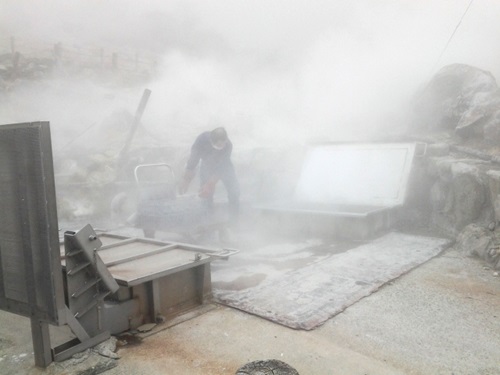ELSI 2015
Blog No.97
Author: Jim Cleaves

So many things are afoot at ELSI it's hard to know where to begin! New people keep coming, a few regulars are moving on to new positions, but the strength and diversity of the scientists at ELSI keeps growing. Besides trying to grow ELSI, we're all trying to get good science done, and we work late into the night. Right now, we're trying to make comprehensive maps or "libraries" of organic compounds in various compound classes: the total nucleic acid-like space, the total Krebs-cycle-like space, the total "Titan-atmosphere"-like space CHN space, and the total "universal organic chemistry" CHNOS space. They are related in fascinating ways I won't go into here (papers forthcoming!). These maps are designed to help scientists make sense of the ever-widening chemistry space which we discover in the universe, which might be useful for everything from designing new antiviral drugs to interpreting the data sent back from solar system space exploration probes, to understanding why biology is the way is. It's hard and constant work, but every now and then we try to take a break and enjoy the world outside of ELSI's kinetic walls.
Last saturday, Marcus Meringer, my colleague visiting from Germany, and I took an impromptu trip to Hakone, about two hours west of Tokyo, where we hoped to see the active hydrothermal fields of a 3000 year old extinct volcano. This involved taking four trains to Hakone-Yumoto, where we initially wandered off, like typical scientists, into nothing productive, until being set straight by some helpful fellow wanderers. We walked back into town and got on the "switchback train," which I was mildly happy to discover there is a word for in both English and Japanese, but not in German, though I had no idea what a "switchback train" was. It turns out that it's a train where when the mountains are too steep, rather than engineer and carve out turns in the tracks, they shunt the train every so often into little dead ends, then the conductor stops the train, walks around to the other end of the train, and the "polarity" of the train changes. Ingenious, if you think about it.
Upon reaching the end of that line, we then had to jump on a Funicular, which is not an English word I am familiar with, but I have been on many of them in Europe. A funicular is supposed to be like an elevator for going straight up a mountain at a steep angle, only in this case there was no obvious counterweight "opposite direction" train. I have no idea what kept the train from backsliding, indeed it felt like it was slipping once or twice.
After the "funicular", we got on a skytram, this was only mildly terrifying, until we crested a ridge and traveled over the actual hydrothermal fields. Then the ground dropped away suddenly, and where we had been 20 feet of the ground we were now 200, and now we were also in the wind tunnel of a mountain pass. The tram started swinging back and forth wildly. I have every faith in engineers, but still I had my throat in my mouth. When we finally reached the top, everything was swirled in fog and the temperature had plummeted to maybe 5° C. It having been "spring" in sea-level Tokyo when we left, we were poorly prepared for the mountain weather. We briefly discussed skipping out on walking out into the cold to see the hydrothermal fields in person, but we had come too far.
The big rewards of the day, besides experiencing so many new and unexpected modes of transportation were the "black eggs" cooked in boiling geothermal fluids sold at the top of the mountain. They turn black due to the deposition of iron sulfides on their shells. It is said that eating one adds seven years to your life. We ate two each, and brought one home for a friend. In retrospect I suppose we probably should have eaten as many as we could have.
On the way down we also heard the sweetest and most unusual bird song, not 10 feet from our ears coming from one of the stunted mountaintop trees, and spent a good while, no longer aware of the cold, trying to find the culprit, but to no avail. As in science, sometimes the sweetest songs come from the most elusive birds.
We took another skytram back down the other side to a caldera lake. All the way, we had time to talk about a lot of things, including molecular libraries. Though we were both so far from our homes, which we both missed, we had a lot of time to talk and think. We ended up taking a bus back to Shinjuku station (we both got good naps in on the way), and then took a tool around Shinjuku. Shinjuku on a Saturday night is as far from a winsome bird song as one can get. But even that gives you a moment to think about the difference between the two.
Overall, it was quite a day, and it struck me as a lot like scientific research: you have a vague (or sometimes very specific) idea of where you want to go, you start off in one direction, then you realize, as you learn more, that the problem is different than what you thought it was when you started, so you switch to a new technique. Then you run that one into the ground, then the next one. You change your approach, and realize there are avenues for moving forward you hadn't conceived of when you started. Along the way, you discover new and unexpected phenomena which raise totally new questions you weren't even asking when you started out. In this case, even the day itself wouldn't have happened without ELSI.
